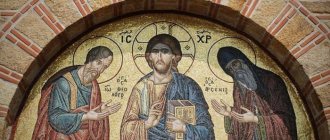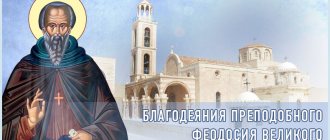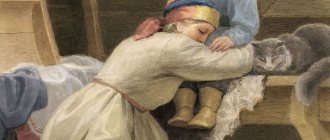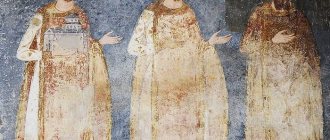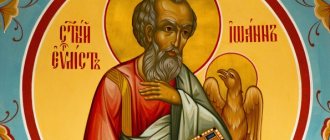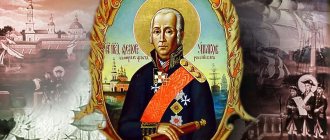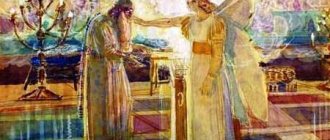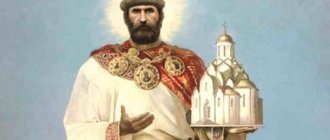Arsenius was born in Rome in 354
In 354, the future Venerable Arseny was born in Rome. The family belonged to a noble family and Arseny received a good education and Christian upbringing. Having studied Greek and Latin and re-read the works of Greek philosophers, he left worldly life and decided to devote himself to God.
Venerable Arseny the Great
Venerable Arseny the Great
While still a young man, he joined the ranks of the clergy. Already a deacon, Saint Arseny became famous for his chastity, leading a pious and virtuous life.
How does prayer to Arseny the Great help?
They pray to St. Arseny the Great in search of spiritual strength, to strengthen faith. The saint grants peace to all who ask, points out the right path and gives strength to overcome difficulties and obstacles along this path.
Through the prayer of Arseny the Great they ask for forgiveness and blessing. He not only instructs, but also protects, driving away sinful thoughts and protecting from enemies. The lost, despairing, broken and tired find in prayer salvation from adversity and support in business. Often those who have taken the righteous path and are looking for strength to serve the Lord, as Arseny did, often read a prayer to the Monk Arseny.
Arseny teaches the sons of Emperor Theodosius
Word of his piety and education reached Constantinople. Theodosius, who at that time ruled the eastern part of the Roman Empire (379 - 395, and from 383 to 395, and the western part), having learned about his extraordinary intelligence and virtue, the emperor decided to entrust Arsenius with raising his sons - Arcadius and Honorius.
29 years
at this age the Monk Arseny left Rome to raise the emperor’s children
At the age of 29, at the insistence of Pope Damasus, the Monk Arsenios was forced to leave Rome. In Constantinople, Arseny was greeted with all honors and Theodosius, entrusting the children to him, said:
“Now you will be more of a father to them than I am, because it is more difficult to raise them than to give birth to them. I entrust them to you and your prudence; bring them up as I ask you; accustom them to virtue and teach them wisdom; as their spiritual father, make sure that they avoid various youthful temptations. ...
I am telling you all this in front of my sons, so that they can hear and see it all for themselves. Do not look at the fact that they are the king's sons; raise them to be obedient and submissive to yourself, because I want them to obey you in everything, as their father and teacher, and to obey you, like your children and disciples.”
Near the palace, Theodosius built a school so that he could come and supervise his sons' education.
Arseny became a good mentor and teacher: he helped children master books and explained the Holy Scriptures.
He also taught children how to behave if they happened to run the state. He inspired that even those sitting on the throne are adorned by good deeds; if they want to leave a good memory of themselves, they must be virtuous, noble rulers who observe Christian commandments.
At the same time, Arseny revered the pupils as royal children. Seeing one day that his sons were sitting and the teacher was standing in front of them, the emperor was indignant:
“Didn’t I tell you that you should consider my sons as your disciples and your children, and not pay attention to the fact that they are the king’s children?”
Theodosius believed that sons should grow up to be worthy people - to honor God, follow his commandments and live a virtuous life. And if this does not happen, then it is better for them not to reign at all.
“I pray to God that He would rather take them out of this life in their youthful years than allow them to grow up in evil, to the destruction of both their own souls and the other souls of men.”
Arseny in his soul approved of the emperor’s words and from then on he taught Arcadius and Honorius while sitting, while his sons stood in front of their mentor.
Arseny is burdened by honors and flees to the hermitage desert
Reverend Arseny.
Icon Dreaming of a monastic life, the Monk Arseny was burdened by a life of prosperity and honor, and fervently prayed to the Lord to show him the path to salvation, to monastic life. And one day while praying, he heard a voice from heaven:
“Arseny, run from people and you will be saved!”
Having taken off his expensive clothes, Arseny put on the clothes of a wanderer, secretly left the palace, and sailed to Alexandria.
Arriving ashore, he went to the hermitage desert, where he immediately asked to be accepted into monasticism. The elders, seeing that in front of them was not the “poor wanderer” that Arseny introduced himself to be, but a complex man, decided to test the stranger’s humility and took him to John Kolov. Meanwhile, the monks gathered for a meal, but John did not invite Arseny to the table.
He stood at a distance.
John threw him, like a dog, a cracker from the table. The Monk Arseny crawled to the cracker and ate it.
Elder John, seeing such humility, told the elders that Arseny would become a great ascetic. Soon Arseny was tonsured a monk, and John gave the new monk a cell not far from his own. Continuing to improve spiritually, spending time in prayer and fasting, the Monk Arseny surpassed many elders in asceticism.
Miracles and veneration of St. Arseny of Novgorod
Arseny was highly revered among the Novgorodians. The first of the miracles described in the Life of the early edition tells about the salvation of the wife of the pious Novgorodian Ivan Martynov . While crossing the Volkhov River on a raft, she slipped and fell into the water. She was pulled under the raft by a strong current, in despair the woman prayed to Arseny of Novgorod, promising to perform prayers for him annually, and unknown how she ended up on another raft.
In 1732, the Arseniev Monastery fell into decay and was assigned to the Yuryev Monastery. In 1785 (1786 or 1787?) the relics of Arseny of Novgorod were found and transferred to the Novgorod monastery of Alexandria in honor of the Intercession of the Most Holy Theotokos and St. Cyril and placed on the south side of the St. Cyril Church . In 1792, a chapel was built over the relics of the saint in his honor, and in 1812 a bronze gilded shrine was erected. In the name of St. Arseny, a chapel in the church in honor of the Vladimir Icon of the Mother of God in Rzhev was also consecrated. In 1830, on the site of the abolished Arseniyev Monastery, the merchant Kuznetsov built a church in honor of the Iveron Icon of the Blessed Virgin Mary, in which there was a tomb where the relics of Arseniy of Novgorod had previously rested.
In the note of the Novgorod archpriest Maxim about the Novgorod shrines, written for Tsarina Evdokia Lukyanovna in 1634, it is said: “On the Trade Side, in the Arsenyev Monastery, the relics of the Monk Arseny lie hidden; From his relics healings come to those who come with faith. The troparion and kontakion have been drawn up for him, but his celebration has not yet been established.” In the Kaidalovsky calendar, Arseny is commemorated on July 14th. The name of Arseny of Novgorod is included in the “ Description of Russian Saints ”. In the Menaia, under July 12, the text of the service to Arseny of Novgorod is placed.
Arseny hears the voice of the Lord “Run from people and remain silent”
One day, while praying, the saint again heard the voice of the Lord:
“Arseny, avoid people and remain in silence - this is the root of sinlessness.”
Since then, Saint Arseny settled in the desert, building himself a small cell.
There he always stayed alone, trying to maintain complete silence, only coming to church on Sundays and holidays. But even then he tried to leave immediately after the service, without entering into conversation with anyone. The monks who lived in the hermitage desert were very amazed at such a life.
When asked by the monks why he was hiding from everyone, the saint answered:
“God sees that I love everyone, but I cannot be with God and people at the same time. The heavenly powers all have one will and unanimously glorify God, but on earth each person has his own will and people’s thoughts are different. I cannot leave God and live with people.”
After the death of Theodosius, Arcadius began to reign, and in the western half of the Roman Empire, Honorius. Having learned about the mentor’s lifestyle, Arkady sent Saint Arseny a message in which he humbly asked for forgiveness for all his sins of youth, asking him to pray for them.
In the same message, Arkady suggested that Arseny use the tribute from Egypt at his discretion, distribute it to monasteries and the needy. The Monk Arseny forgave the brothers' sins and blessed them for a wise reign, sending an envoy with the words that he had long since died for the world and did not need gifts.
The fame of the great Arseny spread far. Many wanted to see him, receive instructions, blessings, thereby disturbing the peace of mind and solitude of the monk. Arseny had to go to other silent, secluded places, distancing himself from conversations with those who came.
However, those who longed to receive his blessing and guidance found the saint. So, having asked him about what is good for the soul, we received the answer:
“Take every care that what you think in your mind pleases God.”
The monk also said:
“If we really seek God with all our hearts, then He Himself will come to us and we will see Him; and if we keep Him close to us with a pure life, then He will remain with us.”
I often liked to repeat:
“I have repented many times about my words, but never about my silence.”
For more than 40 years, Arseny remained alone, alone with God, only occasionally leaving his cell, courageously rejecting worldly temptations.
Like other hermits, Saint Arsenius was content with little: water, a basket of bread per year, and a little fruit if the year was fruitful. He spent his days in prayer, reading psalms and weaving baskets from palm branches.
One day there was a barbarian invasion of the country. All the monks left the monastery for cities and villages, only Saint Arseny remained, thinking like this
“If the Lord does not save me, then I have no reason to live on earth.”
And the Lord hid him from the barbarians. The monastery was plundered, the Monk Arseny was not found.
He did not boast about this and decided to also leave the monastery along the same path as the other ascetics. After the barbarians left the monastery, the monks returned there again. They restored the monastery and began to live on. Arseny also returned to his cell.
The saint did not always live in one place; sometimes he moved to more secluded places, going deep into the desert. So he tried to distance himself from the people who came to him to talk. At one time he was near Babylon, in Kanop, near Alexandria, and other desert places, and again returned to the monastery.
When the time of the death of Saint Arsenius approached, he said to his disciples:
“When I die, do not hold a wake for me, do not gather the brethren for dinner, but just make sure that the Divine Sacrifice is offered for my sinful soul.”
95 years old
Saint Arsenius died at this age
The silent man spent more than 50 years in monastic labors and exploits, receiving the name Great from his contemporaries. The saint died as a very old man at the age of 95.
The labors of Saint Arseny were not in vain - the instructions on monasticism were written down by his disciples. Quotations are used in the book of St. Dmitry of Rostov “Lives of the Saints” (“Life of Arseny the Great”, Life 401), in “Synaxarion: Lives of the Saints of the Orthodox Church”, published by the Sretensky Monastery Publishing House, in APOPHTHEGMATA PATRUM (“Sayings of the Egyptian Fathers”, “Memorable tales of the asceticism of the holy and blessed fathers").
The collection contains sayings, aphorisms and stories of the desert fathers concerning monastic life, spirituality, and principles of ethics. The texts of these sayings, preserved in Latin and Greek, have been translated into other languages of the Christian East. The great Arseny also wrote one of the interpretations of the Gospel of Luke.
ARSENY THE GREAT
St. Arseny the Great. Painting c. Panagia Asinu in Nikitari (Cyprus). 1105/06
St. Arseny the Great. Painting c. Panagia Asinu in Nikitari (Cyprus). 1105/06 (c. 354-449, Troy of Babylon (modern Tura)), St. (memorial May 8, Copt. 13 Pashons, memorial Zap. July 19), Egypt. ascetic. Basic information about him is contained in Apophthegmata Patrum. A.V. belonged to the senatorial class and was the educator of the heirs to the throne Arcadius and Honorius, the sons of the Byzantines. imp. Theodosius I the Great. OK. 394 he left the world and became a monk in the Skete. St. Theodore the Studite mentions that at the beginning of his ascetic life A.V. was a student of St. John Kolov (PG. 90. Col. 853-854). When nomads devastated Skete in 434, A.V. moved to Troy of Babylon, where he remained until 444, and then moved (again in connection with the raids of nomads) to the vicinity of Alexandria. Abba Daniel, a student of A.V., wrote about his teacher that he “never wanted to talk about any controversial passage from Scripture, although he could if he wanted. He rarely even wrote letters. When he came to church from time to time, he stood behind a pillar so that no one would see his face and so that he himself would not look at others. He looked angelic, like Jacob; He was all gray, his body was slender, but dry; he had a long beard, extending below his chest; his eyelashes fell out from crying; He was tall, but from old age he became hunchbacked” (Memorable Tales. P. 27). Among his contemporaries, A.V. became famous for his holiness, and in the memory of later generations he was imprinted as an example of a true silent man (hesychast).
The sayings of A.V. have been preserved as part of the Apophthegmata Patrum (44 of them were published in the Patrology of Min (PG. 34), some were transmitted on behalf of Abba Daniel) and his message translated into cargo. language (in 2 manuscripts of the X-XI centuries). According to the teachings of A.V., monastic life is ideally equal to the angels (one of the main postulates of patristic asceticism), for monks, like angels, must always glorify the Lord with the fear of God and humility. This is impossible without acquiring hesychia, that is, internal peace and external withdrawal from the world (“If you do not withdraw from people, you will not be able to become a monk”). In close connection with hesychia is fasting, “cultivating the soil of the heart” for the growth of the grace-filled seeds of the Holy Spirit in it; Constant vigil and unceasing prayer are the monk’s main weapon in spiritual warfare and allow him to avoid carnal pleasures and other sins. A.V. constantly emphasized the need to acquire the virtues of brotherly love, love of strangers and alms, without which it is impossible to achieve spiritual perfection. Finally, according to A.V., achieving perfection is unthinkable without constant reflection on the Holy Scriptures. Through Scripture, thanks to which one finds spiritual contrition or tenderness.
Source: PG. 65. Col. 87-108 (Russian translation: Memorable legends. P. 18-28); ActaSS. Iul. T. 4. P. 617-631; JSV. May. pp. 244-268; Garitte G. Une “lettre de saint Arsène” en géorgien // Muséon. Louvain, 1955. N 68. P. 259-278; Lettres des Pères du désert: Ammonas, Macaire, Arsène, Serapion de Thmuis. Begrolle-en-Mauges, 1985. R. 85-113; Les Apophthegmes des Pères: Collection system. T. 1 / Éd. par J.-Cl. Guy. P., 1993. P. 74-77. (SC; N 387).
Lit.: CPG, N 5545-5554; Guy J.-Cl. Le center monastique de Scéte au IVe et au début du Ve siècle: Prosopographie et histoire. R., 1963. P. 154-158; idem. Recherches sur la tradition grecque des Apophthegmata Patrum. Brux., 1963. P. 20. (SH; N 36).
A. I. Sidorov
St. Arseny the Great. Painting c. Savior on Ilyin in Novgorod. Master Theophanes the Greek. 1378
St. Arseny the Great. Painting c. Savior on Ilyin in Novgorod. Master Theophanes the Greek. 1378
Based on an ancient story, possibly Roman. origin, about the activities of A.V. as an educator of Arcadius and Honorius (the text was preserved in the manuscript of the Chronicle of St. George the Monk - Paris. Coisl. 305. Fol. 249v. - 251v., 11th century), as well as the Apophthegmata Patrum and the Skete Patericon were compiled in Greek. lengthy lives of A.V. (2 anonymous and attributed to Simeon Metaphrastus), as well as praise of A.V. Theodora Studite. Brief lives are included in the Minology of Vasily II (PG. 117. Col. 441-444) and in the Synaxarion of the K-Polish church. X century (SynCP. Col. 665-666). Although A.V. bequeathed after his death not to bury his body and not to give any honors, according to the report of “Anonymous Mercati” (Latin pilgrimage of the 12th century), the relics of the saint were in the K-Polish church. Our Lady of Triakontaphyllos (Periveleptos), built by imp. Roman III Argir in 1034 (Description of the shrines of the K-field. P. 452). It is unknown where the relics of A.V. were previously located. The initial minor veneration of A.V. in the K-field is evidenced by the absence of his memory in all lists of the Typikon of the Great Church. IX-X centuries Starting from the 2nd half. XI century His memory is celebrated on May 8 in most Byzantine countries. calendars.
The veneration in Rus' is evidenced by the mentions of A.V. in manuscripts of the 11th century: his memory is noted in the monthly book of the Archangel Gospel of 1092 (L. 161ob.), the service with the canon of John the monk is included in the Putyatin Menaion of the 11th century. (RNB. Soph. No. 202. L. 29v. - 37v.). In the 1st half. XII century in Rus', a translation of the short life of A.V. was carried out, included in the non-verse Prologue, which was supplemented, in comparison with the life found in the Minology of Basil II, with an excerpt from the Apophthegmata Patrum (the will of the ascetic, a description of his appearance, the chronology of life) (the oldest list : RGADA. Sin. type. No. 174. Sheets 60-60v., 1st half of the 14th century).
The extensive life (BHG, N 167z) is part of the Volokolamsk Chetya-Minea of the 15th century. (RGB. Vol. 597), presumably dating back to the original of the 12th century. The VMC includes this life and praise of St. Theodore Studite (BHG, N 169) (Joseph, archimandrite. Table of contents of the HMCH. Stb. 150-151, 153 (2nd page)).
Dr. a lengthy life, rewritten by the hand of St. Nile of Sorsky, placed in his hagiographic collection (RGB. Volok. No. 630. L. 264-271ob., late 15th - early 16th centuries), which testifies to the authority of A.V.’s spiritual example for Elder Nile, to- ry in his will also forbade paying honor to his relics (Borovkova-Maikova. p. 10). List of the life of A.V., found in the manuscript of the con. XV - beginning XVI century (RGB. MDA. No. 207. L. 67-75ob.), is an exact copy of the autograph life of Nil Sorsky. In addition to the life, these manuscripts contain excerpts from the Patericon about Abba Arseny.
Source: BHG, N 167y - 169z; Tsereteli G. F. The Life of Our Father Arseny the Great, Like the Saints, According to the Manuscripts of the Moscow Synodal Library. St. Petersburg, 1899; Borovkova-Maikova M.S. Nil Sorsky Tradition and Charter. SPb., 1912. (PDPI; T. 179); Description of the shrines of K-field in a Latin manuscript of the 12th century: Trans. from lat. // Miraculous icon in Byzantium and Ancient Rus'. M., 1996. pp. 436-463.
O. V. Loseva, E. V. Romanenko
St. Arseny the Great. Pill icon. XV century (NGOMZ). Fragment
St. Arseny the Great. Pill icon. XV century (NGOMZ). Fragment
Hymnography. Various editions of the Studite Charter - Studite-Alexievsky Typikon of 1034 (Pentkovsky. Typikon. P. 343), Evergetid Typikon of the 1st half. XII century (Dmitrievsky. Description. T. 1. P. 452-453), Messinian Typicon of 1131 (Arranz. Typicon. P. 150-151) - indicate the connection of the sequences of A.V. and Apostle. John the Theologian. Among the monuments of the Jerusalem Charter, the memory of the saint is already contained in its early editions (for example, Sinait. gr. 1096, XII century - Dmitrievsky. Description. T. 3. P. 48). The Typikon, now used in the Russian Orthodox Church (Typikon. T. 2. P. 622), like the monuments of the Studite Charter, prescribes the performance of the service of A.V. and St. John the Theologian, it should be noted that this is the only indication of the combination of the sequences of the vigil (see Signs of the feasts of the monthly) and the lesser saints in the monthly part of the Typikon.
The succession of A.V., known from the description given in the Evergetid Typikon, and consisting of the canon of John the monk of the 4th plagal, i.e., the 8th tone, sedalna and stichera, has generally not changed since the time of the Studite Rule ( for example, GIM Syn. No. 166. L. 33ob., 12th century - Gorsky, Nevostruev. Description. Dept. 3. Part 2. P. 61) and included in modern. printed Greek and Russian Menaia. According to Greek manuscripts know another canon of A.V., Theophanes, with the acrostic “Τὸν ανάρστον ν ἀσκηταῖς ακάρν υδανω” (Greek - I honor the best in the ascetics of the blessed one), not included in printed liturgical books (Τα μεῖον. Ν 600. Σ. 198).
O. V. Venzel
Iconography. To Byzantium. and Old Russian In art, A.V. is depicted as a handsome old man with gray curly hair and a long beard, divided into twisted strands, in a monastic robe (cassock and mantle, usually visible under the robe), with a doll on his shoulders, holding a cross or scroll in his hand. In "Erminia" by Dionysius Furnoagrafiot, beginning. XVIII century, described as “a curly-haired old man with a long and wide beard, says: brothers, why did you come out (from the world), strive for this, and do not neglect your salvation” (Part 3. § 13. No. 4); in the iconographic original of S. T. Bolshakov, 18th century, it is said about A. V.: “Sed, Sergius’s brada is hem and wider, a venerable robe, under a robe with white, in his hand is a scroll: Arseny, run man, be silent, stop, keep silent and be saved” (p. 96).
St. Arseny the Great. Miniature from Greco-cargo. manuscripts. XV century (RNB. OI 58. L. 46 vol.). Fragment
St. Arseny the Great. Miniature from Greco-cargo. manuscripts. XV century (RNB. OI 58. L. 46 vol.). Fragment
Early images of A.V. have been preserved, for example, in the churches of Cappadocia: St. John the Baptist (No. 4) in Gülü-Dere, between 913-920; “on the tank” in Avchilar, 1st floor. XI century; Timios Stavros in Mustafapasa, 10th century; New center Tokali Kilise in Goreme, con. X century; St. Eustathius (No. 11) in Goreme, 1148-1149; Ayvalı Kilise in Goreme, between 913-920; also in the naos of the katholikon of the Hosios Loukas monastery in Phokis (Greece), 30s. XI century; in the narthex c. Nea Moni on the island of Chios (Greece), 1042-1056; in Minology of the 11th century. (Messan. Salvad. 27. Fol. 286v (280r)) - with the codex, in a medallion (only a preliminary drawing has survived); in c. Bachkovo monastery, con. XI - beginning XII century; in c. Asinu Panagia (Forviotissa) in Nikitari (Cyprus), 1105/06; in Minology of the 12th century. from the Monastery of the Transfiguration of the Lord in Meteora (Cod. 552. Fol. 2v) - before the life of A.V.; in the Lives of the Saints according to Metaphrastus, XII century. (Paris. gr. 1528. Fol. 1r) - with an unfolded scroll; in c. Vmch. Panteleimon at Nerezi near Skopje (Macedonia), 1164; in the cathedral in Montreal (Sicily), 1180-1190; in the monastery of St. Neophyte in Paphos (Cyprus), 1183; in c. Ascension of the Lord in Mileshevo, after 1236; in the monastery of Pammakaristos (Fethiye Jami), approx. 1315; to the south wall in c. Vmch. George in Staro Nagorichino (Macedonia), 1317-1318; in c. Annunciation of the Virgin Mary at Gracanica Monastery (Yugoslavia, Serbia), ca. 1320; to the south wall in the west parts c. St. Clement in Ohrid (Macedonia), 1378, - with a blessing right hand and with a scroll in his left hand; in c. Our Lady of Pantanassa in Mystras (Greece), 2nd quarter. XV century; in Greco-cargo. manuscripts of the 15th century. (RNB. OI 58. L. 46v., 113).
Iconography of A. V. in Old Russian. art follows Byzantium. traditions, eg. in the painting c. Dormition of the Virgin Mary on Volotovo Field in Novgorod, 80s. XIV century; on the fresco of Theophanes the Greek in the c. Savior on Ilyin in Novgorod, 1378
Miniatures with scenes from the life of A.V., for example. “The Reverend teaches the sons of the Emperor. Theodosius the Great Arcadius and Honorius" in Minology early. XI century (GIM. Greek. 9. Fol. 1r), “The Repose of the Saint” (4 monks place the body of A.V. in the coffin) - in the Minology of the 12th century. (Paris. gr. 1528. Fol. 21r).
Lit.: Erminia DF. P. 170; Bolshakov. The original is iconographic. P. 96; Evseeva. Athos book. pp. 198, 301; Mujožuž. Menologist. P. 299.
N. V. Gerasimenko, V. E. Suslenkov
Icon of Saint Arsenios
Arseny the Great (handwritten icon)
May 8
Arseny's name day in Orthodoxy, July 19 - in Catholicism
Arseny's name day is May 8 in Orthodoxy, July 19 in Catholicism.
On the Orthodox icon, Arseny is depicted as a handsome, gray-haired and gray-bearded old man with a merciful, kind look. In his left hand, Arseny holds the Gospel (on some icons - a scroll), his right hand is raised in a blessing gesture.
Those Christians who want to curb pride, envy and hatred, talkativeness and idle talk turn to the saint.
external reference
| Wikiquote has quotations related to: Arsenius the Great |
| Portals Access related topics |
|
| Authoritative control |
|
Quotes from St. Arseny
One day, Blessed Archbishop Theophilus and some commander came to Arseny and asked the elder, wanting to hear a word from him. The elder, after a short silence, said to them in response: will you do what I tell you? They promised to fulfill. Then the elder told them: if you hear about Arseny anywhere, do not go to him.
One day the Monk Arseny came to a place where a lot of reeds grew. He found monks here sitting near the reeds. Since the reeds were rustling from the wind, the monk asked the monks:
-Where does this noise come from?
The monks answered him:
“It’s the reeds that are making noise from the wind.”
Then the monk said to them:
- Why are you sitting here and listening to the noise of the reeds? Anyone who truly loves silence should not even listen to the singing of birds, which can disturb the peace of mind; all the more so can the noise of the reeds confuse the heart of a monk.
“I know the secular science of the Greeks and Romans well; but I don’t even know the ABCs of what a simpleton knows about living a virtuous life. There are many people who try in every possible way to maintain bodily purity and for this they mortify their bodies with fasting, vigil and many labors; but there are few who jealously protect their souls from the sins of vanity, pride, love of money, envy, brotherly hatred, anger, resentment, and condemnation. Such people are externally pure in body, but their soul is dirty; they are like coffins, decorated on the outside but full of stinking bones on the inside. Blessed is the one who tries to preserve both his body and soul from defilement; truly blessed are the pure in heart (and not just in body), because they will see God.
Video: Life of our Venerable Father Arseny the Great.
By leaving a comment, you accept the user agreement
Troparion and Kontakion to St. Arseny of Novgorod
Troparion, tone 8.
ABOUT! you, Father Arseny, know the speed of salvation. Let us accept the cross, for you followed Christ. But whoever does and learns to despise the flesh passes away, but to practice things more immortal for the soul. In the same way the angels rejoice, O venerable spirit.
Kontakion, tone 2.
Having divinely armed yourself with spiritual purity, and unceasing prayer, as if you had firmly handed over a copy, you prosecuted the demonic host Arseny, Our Father, pray unceasingly for all of us.
